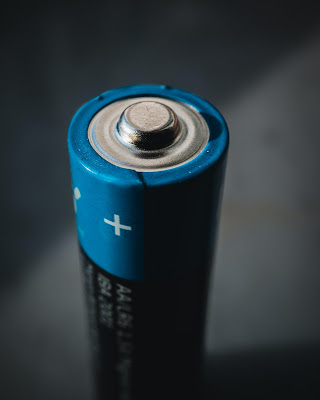 |
| A macro shot of a normal AA type battery cell by |
Introduction
Futuristic batteries are a topic of interest for many scientists, engineers, and consumers as we continue to rely on portable electronic devices and seek more sustainable energy solutions. There are several promising technologies that are being developed or have the potential to revolutionize the way we store and use energy in the future. Here, we will discuss some of these technologies and their potential impact.
Solid-State Batteries
One of the most exciting areas of research in batteries is the development of solid-state batteries. These batteries use solid electrodes and electrolytes rather than the liquid ones found in traditional lithium-ion batteries. This makes them potentially safer, as they are less prone to overheating and combustion. Solid-state batteries also have the potential to have higher energy densities, meaning they can store more energy in a smaller package. This could lead to longer-lasting batteries for portable devices and potentially even electric vehicles. They are considered to be a promising technology for a number of reasons.
One advantage of
solid-state batteries is that they are potentially safer than traditional
lithium-ion batteries. The use of solid electrodes and electrolytes means that
they are less prone to overheating and combustion, which can be a concern with
traditional batteries. This could make solid-state batteries a good choice for
use in applications where safety is a concern, such as electric vehicles.
Solid-state batteries
also have the potential to have higher energy densities than traditional
lithium-ion batteries. This means that they can store more energy in a smaller
package, which could lead to longer-lasting batteries for portable electronic
devices and potentially even electric vehicles.
Another potential advantage
of solid-state batteries is that they may be able to be charged more quickly
than traditional lithium-ion batteries. This could make them more convenient
for use in applications where fast charging is important, such as electric
vehicles.
However, it should be
noted that solid-state battery technology is still in the early stages of
development and there are several challenges that need to be overcome before it
can be widely commercialized. These challenges include finding materials that are
stable and efficient enough for use in solid-state batteries, as well as
finding ways to mass-produce solid-state batteries at a competitive cost.
Alternative Materials for Battery Electrodes
Another area of research is the use of alternative materials for battery electrodes. There are several alternative materials that are being explored for use as battery electrodes in place of traditional materials such as graphite or lithium cobalt oxide. Some of these materials include:
Graphene: Graphene is a form of carbon that is only one atom thick. It has high conductivity and strength and is also lightweight and flexible. These properties make it an attractive material for use in battery electrodes. These properties could make it useful in a variety of applications.
Silicon: Silicon has a
high capacity for storing lithium ions, which makes it a promising material for
use in battery electrodes. However, it tends to expand and contract during the
charging and discharging process, which can lead to the degradation of the battery
over time. Researchers are working on ways to overcome this issue.
Metal oxides: Metal
oxides such as tin oxide and vanadium oxide have been explored as alternative
materials for battery electrodes. These materials have a high capacity for
storing lithium ions, but they can be costly to produce and may have other
limitations such as low electrical conductivity.
Conductive polymers:
Conductive polymers are a type of plastic that can conduct electricity. They
have been explored as an alternative to traditional battery materials due to
their potential for low cost and ease of production.
The development of
alternative materials for battery electrodes is an active area of research as
scientists and engineers seek to improve the performance and sustainability of
batteries. However, it should be noted that these materials are still in the
early stages of development and there are several challenges that need to be
overcome before they can be widely commercialized.
Modern Ways of Charging Batteries
In addition to these material-based approaches, researchers are also exploring new ways to charge batteries. Wireless charging is one technology that is already in use, but there are several other methods being developed that could make charging even more convenient in the future. Some of these include:
Wireless charging:
Wireless charging technology allows devices to be charged without the need for
a physical connection. This can be achieved through the use of electromagnetic
fields, which transfer energy from a charging pad to the device being charged.
Ambient energy charging:
Researchers are exploring ways to charge batteries using ambient energy sources
such as sunlight or body heat. This could potentially allow devices to be
charged without the need for a power outlet.
Nanowire-based charging:
Nanowires are extremely small wires that can be used to create high-speed
charging capabilities. Researchers are exploring the use of nanowires in
battery charging to create faster and more efficient charging systems.
Solar charging: Solar
panels can be used to charge batteries directly, making it possible to charge
devices in off-grid or remote locations.
Kinetic charging:
Kinetic charging involves using the motion of an object to generate
electricity. This could potentially be used to charge batteries in devices that
are in motion, such as wearable devices or electric vehicles.
These modern charging
technologies have the potential to make charging batteries more convenient and
efficient and could help to improve the performance and sustainability of
electronic devices and energy systems.
Conclusion
The future of batteries
looks bright with many exciting technologies on the horizon. These technologies
have the potential to improve the performance and sustainability of our
electronic devices and energy systems and could help us to transition to a
more energy-efficient society.

Comments
Post a Comment